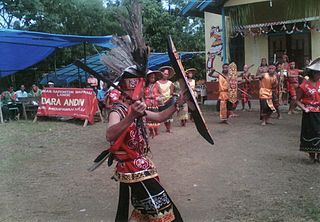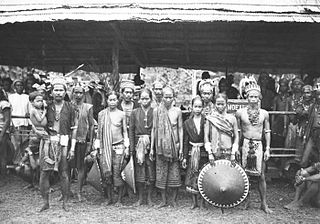The Batin are a sub-group of Malay people that inhabits the interior parts of Jambi province

Satu Suro is the first day of the Javanese calendar year in the month of Suro, corresponding with the first Islamic month of Muharram. It is mainly celebrated in Java, Indonesia, and by Javanese people living elsewhere.

The Kendayan are an Indonesian ethnic group native to Kalimantan, Indonesia in Borneo. The population of the group is around 366,000.
The Ulu scripts, locally known as Surat Ulu are a family of writing systems found in central and south Sumatra, in the regions of Kerinci, Bengkulu, Palembang and Lampung, Indonesia. They were used to write manuscripts in Sumatran languages and Malay, such as the Tanjung Tanah Code of Law. The Malay writing was gradually replaced by the Jawi script, a localized version of the Arabic script.
Kendayan, or Salako (Selako), is a Malayic Dayak language of Borneo. The exact number of speakers remains unknown, but is estimated to be around 350,000.

Gorontalo people, also known as Gorontalese are a native ethnic group and the most populous ethnicity in the northern part of Sulawesi. The Gorontalo people have traditionally been concentrated in the provinces of Gorontalo, North Sulawesi, and the northern part of Central Sulawesi.

Mualang are an indigenous people of West Kalimantan from the Dayak group and a sub-ethnic of the Iban people. They speak the Mualang language and they are mostly concentrated in areas in the Sekadau Regency and Sintang Regency of West Kalimantan, Indonesia. The specific districts where the Mualang people live include:
- Belitang Hilir district, Sekadau
- Belitang district, Sekadau
- Belitang Hulu district, Sekadau
- Sepauk, Sintang and its surrounding region

The Pandat is the war sword of the Dayak people of northwest Borneo and is never used as a tool. On October 18, 2016, this weapon was featured in season 3 episode 9 of the American bladesmithing competition series Forged in Fire.

Sumedang Larang is an Islamic Kingdom based in Sumedang, West Java. Its territory consisted of the Parahyangan region, before becoming a vassal state under the Mataram Sultanate.

The Kanta is a traditional shield of the Toraja and Pamona people of Tana Toraja Regency, South Sulawesi and Poso Regency, Central Sulawesi, Indonesia respectively.

The Lampung or Lampungese are an indigenous ethnic group native to Lampung and some parts of South Sumatra, Bengkulu, as well as in the southwest coast of Banten. They speak the Lampung language, a Lampungic language estimated to have 1.5 million speakers.

The Muna or Wuna are the indigenous group which primarily inhabit the islands of Buton and Muna. They speak languages from the Muna-Buton language group.

Rangkiang is a granary or rice barn that the Minangkabau people used to keep rice in. The rangkiang is a distinctive feature of Minangkabau architecture. The structure is traditionally found in the courtyard of a rumah gadang, the traditional house of Minangkabau people.

Soerabaia 45 is an Indonesian film released in 1990. The film was directed by Imam Tantowi and starred Nyoman Swadayani, Leo Kristi, and Usman Effendy. The story of the film is based on the 1945 Battle of Surabaya between pro-independence Indonesian soldiers and militia against British and British Indian troops as a part of the Indonesian National Revolution.

Banten Sundanese or Bantenese is one of the Sundanese dialects spoken predominantly by the Bantenese — an indigenous ethnic group native to Banten — in the westernmost region of the island of Java, and in the western Bogor Regency, as well as the northwestern parts of Sukabumi Regency. A variety of Bantenese is spoken by the Ciptagelar people in the Kasepuhan Ciptagelar traditional community in the Cisolok district and the Kasepuhan Banten Kidul traditional community in the Lebak Regency.

A balairung is a village hall of the Minangkabau people of West Sumatra, Indonesia. It has a similar architectural form to the rumah gadang, the domestic architecture of the Minangkabau people. Whereas a rumah gadang is a proper building, the balairung is a pavilion-like structure used solely for holding a consensus decision-making process in the Minang society.

Islam in Central Sulawesi, a province of Indonesia, is the majority religion embraced by around 75% of the province's 2,683,722 inhabitants . The propagators of Islam were thought to enter Central Sulawesi through neighboring regions, namely Bone, Wajo, and Mandar from the south and west routes, and through Gorontalo and Ternate from the north and east routes via Tomini Bay and Tolo Bay.
A Pujungan Inscription, also called Bronze Tongtong Inscription, is a short inscription written on a copper slit drum, which was found in the village of Pujungan in Pupuan District, Tabanan Regency, Bali, Indonesia. This inscription is thought to have been written during the reign of King Anak Wungsu in the 11th century. This is the first inscription that mentions the name Sasak, the name of the indigenous people of Lombok island.

Bedil tombak or bedil tumbak is a type of early firearm from the Indonesian archipelago. The weapon consists of a gun or small cannon mounted on a wooden pole, forming a type of weapon known as "pole gun".

Penai is a machete-like sword found in Sulawesi, Indonesia. Traditionally, it is used for both war and agricultural tools. It is used by the Bare'e speaking Torajan people and Pamona people.




















